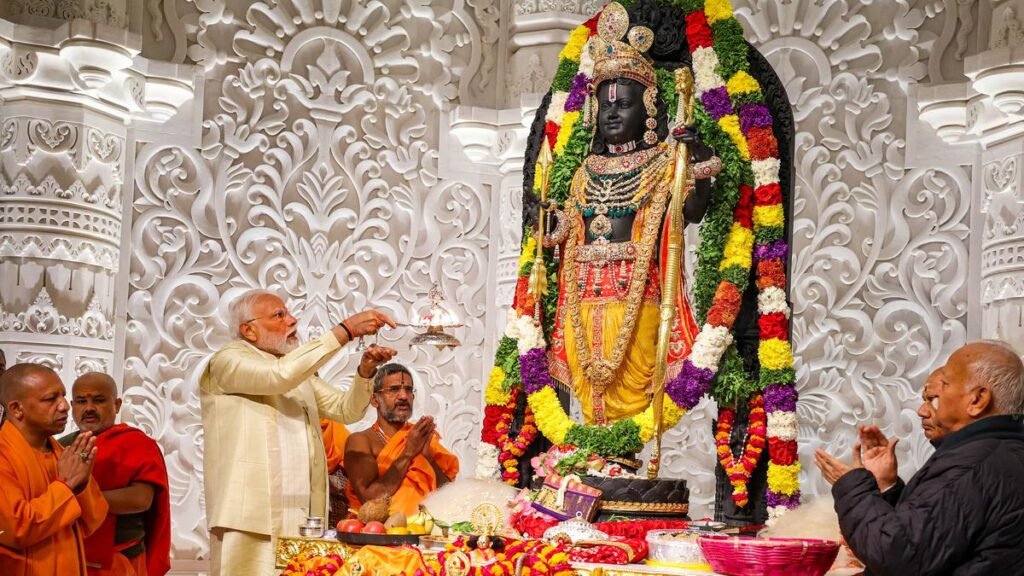The consecration ceremony, known as ‘pran pratishtha,’ for the idol of Lord Ram at the Ram Temple in Ayodhya unfolded on Monday, marked by the resonance of hymns and the execution of sacred rituals. Prime Minister Narendra Modi and various dignitaries graced the occasion, considering it a historic day. Mr. Modi, an active participant in the ceremony and one of the empowered yajmans, described the event as a momentous occasion, comparable to a nation rising beyond the shackles of a slave mentality and drawing strength from its historical adversities to forge a new chapter.
During the ceremony, Mr. Modi, vested with the authority to conduct the ritual, undertook the ‘sankalp’ for the pran pratishtha. He proceeded to enter the temple’s sanctum sanctorum, carrying a silver ‘chattar’ on a red folded cloth for the prescribed rituals. The Ramjanmabhoomi Teerth Kshetra Trust, responsible for the temple’s construction, also designated 16 other individuals from diverse backgrounds as yajmans for the event. Noteworthy figures included the Domraja of Kashi, Anil Chaudhary, the custodian of the flame at Manikarnika Ghat in Varanasi, Mahadev Gaikwad, and Anil Mishra and his wife Usha Mishra, recognized as the “pradhan yajman” of the consecration rituals.
The sacred rituals transpired within the sanctum sanctorum during the highly auspicious “Abhijeet Muhurta,” as per Vedic astrology. Following the ceremony, Mr. Modi concluded his 11-day fast, a spiritual preparation for the rituals, with Govind Dev Giri, a member of the Teertha Trust, offering him some charanamrit.
In his address to the assembly of approximately 8,000 dignitaries and guests, the Prime Minister declared that Ram Lalla, the deity, would no longer reside in a “tent,” alluding to the temporary arrangement following the Babri Masjid’s destruction. He characterized the moment as not just a triumph but also an embodiment of humility, inviting those who had opposed the Ram Temple to join and share in the profound experience.
Thanks judiciary
Expressing gratitude to the judiciary for upholding the sanctity of law and justice, Mr. Modi emphasized that the construction of the grand temple adhered to a judicial process. He highlighted the presence of Lord Ram in the first copy of the Constitution and acknowledged the legal battles surrounding the existence of Lord Shri Ram even after the Constitution’s enactment. Mr. Modi expressed appreciation for the judiciary’s role in maintaining the integrity of justice and remarked that the construction of the Lord Ram temple, synonymous with justice, also followed a judicial path.
Addressing the “critics” of the temple, the Prime Minister urged introspection. He described the temple as a symbol of peace and harmony, countering earlier apprehensions that its construction might lead to unrest. Mr. Modi asserted that those who doubted the peaceful nature of Indian society failed to understand its inherent purity.
Characterizing the Ram Temple as a symbol of peace, patience, harmony, and the maturity of Indian society, Mr. Modi called upon individuals to reconsider their perspectives. His audience included prominent figures from diverse fields, such as seers involved in the Ram Temple movement, industrialists like Mukesh Ambani and family, film stars including Rajinikanth and Amitabh Bachchan, and Uttar Pradesh Governor Anandiben Patel.
Spirit of service
Addressing the inclusive and service-oriented ethos depicted in the Ramayana and the life of Lord Ram, the Prime Minister highlighted the valuable lessons to be gleaned from these characters. Mr. Modi emphasized the importance of learning service and loyalty from Lord Hanuman, resilience from Adivasi mother Shabari, and the spirit of assistance from the Nishad Raj, who aided Ram and Sita in crossing the Ganga.
The Prime Minister acknowledged the contributions of even the smallest creatures, such as squirrels, in the construction of the Ram Setu. He cited the bravery of Jatayu, who faced Ravana to save Sita despite knowing he would be defeated.
Expressing regret, Mr. Modi sought forgiveness from Lord Ram for the centuries-long wait until the present consecration, suggesting that there may have been deficiencies in past efforts.
Looking ahead, Mr. Modi pondered the future after the consecration of the Ram Temple. He envisioned the grand temple as a symbol witnessing the ascent of a magnificent India. The Prime Minister urged a collective pledge to build a capable, developed, magnificent, and divine India, emphasizing that achieving such goals is possible with unified and organized strength. He viewed this moment as a crucial step toward nation-building.
Subsequently, Mr. Modi visited Kuber Tila in the southwestern part of the temple complex, housing an ancient temple of Lord Shiva, where he offered prayers. The location holds significance for Hindu-Muslim unity and played a key role during the First War of Independence. Additionally, the Prime Minister met with workers involved in the construction of the Ram Temple.
Designed in the Nagara style by Chandrakant Sompura and his son Ashish, the temple features an idol of the Lord Rama deity sculpted by Arun Yogiraj of Mysuru.
